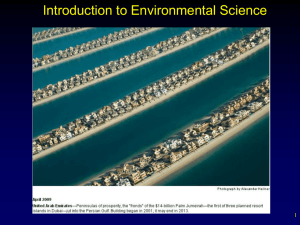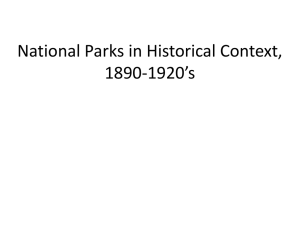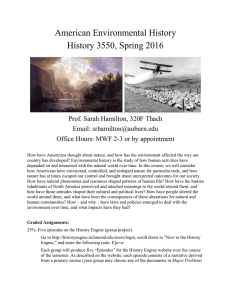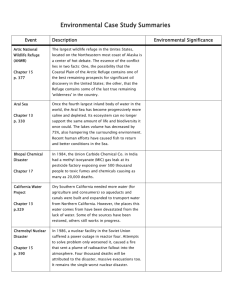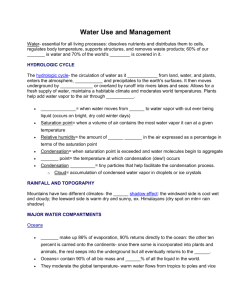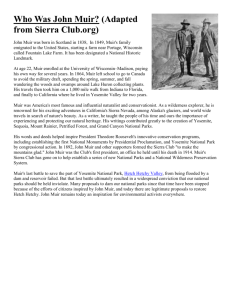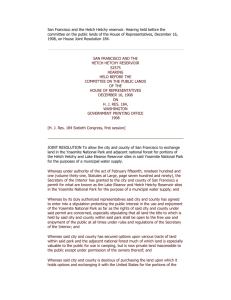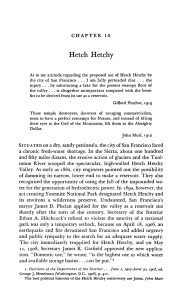O. Block Day Oct. 9-10--Hetch Hetchy Debate
advertisement
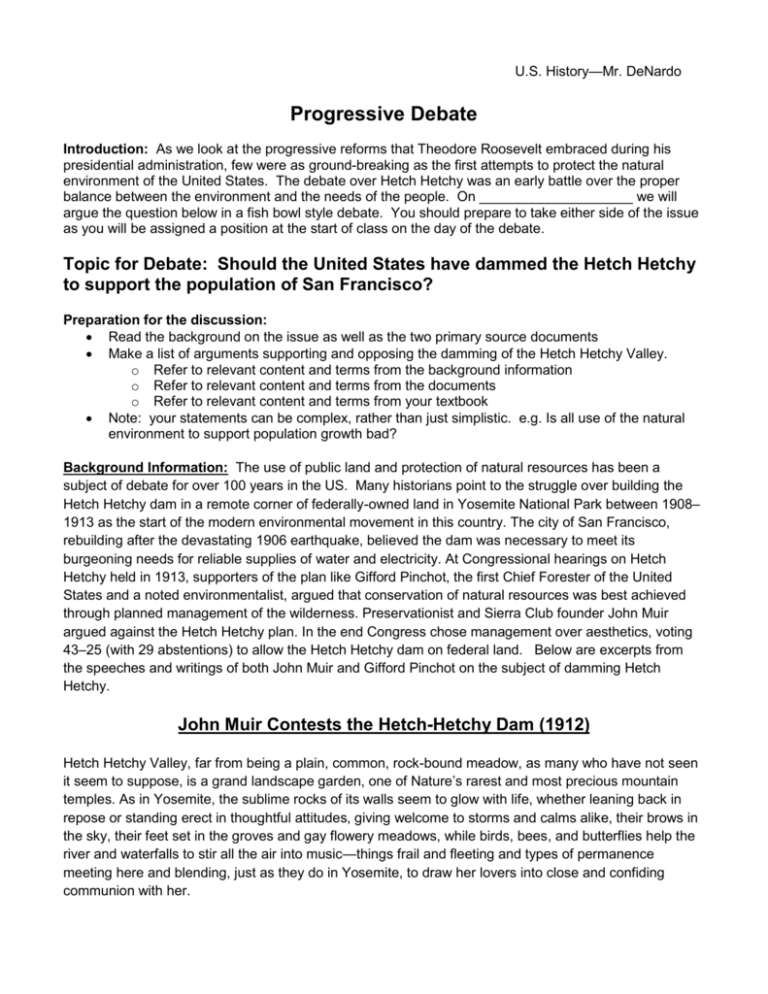
U.S. History—Mr. DeNardo Progressive Debate Introduction: As we look at the progressive reforms that Theodore Roosevelt embraced during his presidential administration, few were as ground-breaking as the first attempts to protect the natural environment of the United States. The debate over Hetch Hetchy was an early battle over the proper balance between the environment and the needs of the people. On ____________________ we will argue the question below in a fish bowl style debate. You should prepare to take either side of the issue as you will be assigned a position at the start of class on the day of the debate. Topic for Debate: Should the United States have dammed the Hetch Hetchy to support the population of San Francisco? Preparation for the discussion: Read the background on the issue as well as the two primary source documents Make a list of arguments supporting and opposing the damming of the Hetch Hetchy Valley. o Refer to relevant content and terms from the background information o Refer to relevant content and terms from the documents o Refer to relevant content and terms from your textbook Note: your statements can be complex, rather than just simplistic. e.g. Is all use of the natural environment to support population growth bad? Background Information: The use of public land and protection of natural resources has been a subject of debate for over 100 years in the US. Many historians point to the struggle over building the Hetch Hetchy dam in a remote corner of federally-owned land in Yosemite National Park between 1908– 1913 as the start of the modern environmental movement in this country. The city of San Francisco, rebuilding after the devastating 1906 earthquake, believed the dam was necessary to meet its burgeoning needs for reliable supplies of water and electricity. At Congressional hearings on Hetch Hetchy held in 1913, supporters of the plan like Gifford Pinchot, the first Chief Forester of the United States and a noted environmentalist, argued that conservation of natural resources was best achieved through planned management of the wilderness. Preservationist and Sierra Club founder John Muir argued against the Hetch Hetchy plan. In the end Congress chose management over aesthetics, voting 43–25 (with 29 abstentions) to allow the Hetch Hetchy dam on federal land. Below are excerpts from the speeches and writings of both John Muir and Gifford Pinchot on the subject of damming Hetch Hetchy. John Muir Contests the Hetch-Hetchy Dam (1912) Hetch Hetchy Valley, far from being a plain, common, rock-bound meadow, as many who have not seen it seem to suppose, is a grand landscape garden, one of Nature’s rarest and most precious mountain temples. As in Yosemite, the sublime rocks of its walls seem to glow with life, whether leaning back in repose or standing erect in thoughtful attitudes, giving welcome to storms and calms alike, their brows in the sky, their feet set in the groves and gay flowery meadows, while birds, bees, and butterflies help the river and waterfalls to stir all the air into music—things frail and fleeting and types of permanence meeting here and blending, just as they do in Yosemite, to draw her lovers into close and confiding communion with her. Sad to say, this most precious and sublime feature of the Yosemite National Park, one of the greatest of all our natural resources for the uplifting joy and peace and health of the people, is in danger of being dammed and made into a reservoir to help supply San Francisco with water and light, thus flooding it from wall to wall and burying its gardens and groves one or two hundred feet deep. This grossly destructive commercial scheme has long been planned and urged (though water as pure and abundant can be got from sources outside of the people’s park, in a dozen different places), because of the comparative cheapness of the dam and of the territory which it is sought to divert from the great uses to which it was dedicated in the Act of 1890 establishing the Yosemite National Park. The making of gardens and parks goes on with civilization all over the world, and they increase both in size and number as their value is recognized. Everybody needs beauty as well as bread, places to play in and pray in, where Nature may heal and cheer and give strength to body and soul alike. This natural beauty-hunger is made manifest in the little window-sill gardens of the poor, though perhaps only a geranium slip in a broken cup, as well as in the carefully tended rose and lily gardens of the rich, the thousands of spacious city parks and botanical gardens, and in our magnificent National parks—the Yellowstone, Yosemite, Sequoia, etc.—Nature’s sublime wonderlands, the admiration and joy of the world. Nevertheless, like anything else worthwhile, from the very beginning, however well-guarded, they have always been subject to attack by despoiling gain-seekers and mischief-makers of every degree from Satan to Senators, eagerly trying to make everything immediately and selfishly commercial, with schemes disguised in smug-smiling philanthropy. . . That anyone would try to destroy [Hetch Hetchy Valley] seems incredible; but sad experience shows that there are people good enough and bad enough for anything. The proponents of the dam scheme bring forward a lot of bad arguments to prove that the only righteous thing to do with the people’s parks is to destroy them bit by bit as they are able. Their arguments are curiously like those of the devil, devised for the destruction of the first garden. . . . These temple destroyers, devotees of ravaging commercialism, seem to have a perfect contempt for Nature, and, instead of lifting their eyes to the God of the mountains, lift them to the Almighty Dollar. Dam Hetch Hetchy! As well dam for water-tanks the people’s cathedrals and churches, for no holier temple has ever been consecrated by the heart of man. Gifford Pinchot Testifies to Congress on the Damming of Hetch Hetchy (1913) . . . So we come now face to face with the perfectly clean question of what is the best use to which this water that flows out of the Sierras can be put. As we all know, there is no use of water that is higher than the domestic use. Then, if there is, as the engineers tell us, no other source of supply that is anything like so reasonably available as this one; if this is the best, and, within reasonable limits of cost, the only means of supplying San Francisco with water, we come straight to the question of whether the advantage of leaving this valley in a state of nature is greater than the advantage of using it for the benefit of the city of San Francisco. Now, the fundamental principle of the whole conservation policy is that of use, to take every part of the land and its resources and put it to that use in which it will best serve the most people, and I think there can be no question at all but that in this case we have an instance in which all weighty considerations demand the passage of the bill. There are, of course, a very large number of incidental changes that will arise after the passage of the bill. The construction of roads, trails, and telephone systems which will follow the passage of this bill will be a very important help in the park and forest reserves. The national forest telephone system and the roads and trails to which this bill will lead will form an important additional help in fighting fire in the forest reserves. As has already been set forth by the two Secretaries, the presence of these additional means of communication will mean that the national forest and the national park will be visited by very large numbers of people who cannot visit them now. I think that the men who assert that it is better to leave a piece of natural scenery in its natural condition have rather the better of the argument, and I believe if we had nothing else to consider than the delight of the few men and women who would yearly go into the Hetch Hetchy Valley, then it should be left in its natural condition. But the considerations on the other side of the question to my mind are simply overwhelming, and so much so that I have never been able to see that there was any reasonable argument against the use of this water supply by the city of San Francisco. . . . Mr. PINCHOT: You might say from the standpoint of enjoyment of beauty and the greatest good to the greatest number, they will be conserved by the passage of this bill, and there will be a great deal more use of the beauty of the park than there is now. Mr. [John] RAKER: [California Congressman]: Have you seen Mr. John Muir’s criticism of the bill? You know him? Mr. PINCHOT: Yes, sir; I know him very well. He is an old and a very good friend of mine. I have never been able to agree with him in his attitude toward the Sierras for the reason that my point of view has never appealed to him at all. When I became Forester and denied the right to exclude sheep and cows from the Sierras, Mr. Muir thought I had made a great mistake, because I allowed the use by an acquired right of a large number of people to interfere with what would have been the utmost beauty of the forest. In this case I think he has unduly given away to beauty as against use. Discussion process: You will be assigned a side-preservationist or wise-use conservationist-- when class begins. Your side will have a few minutes to decide which members of the team will start in the fishbowl. People will “tap into” the fishbowl when they have something to contribute. You can only “tap” a person who is arguing the same side of the issue as you. Grading format: This is a team effort. The entire class will get the same grade, with 2 exceptions: students who do not participate at all will be marked down; students who perform truly exceptionally (without taking over—3 especially articulate and compelling thoughts/arguments) will be marked up. Everyone is expected to “tap into” and contribute to the discussion at least once. Contributions can take the following forms: Summarizing or clarifying information from any of the available sources Asking insightful questions Commenting or giving an opinion Responding to comments from the other side Asking for new information or clarification An ‘A” Debate would look like this: 1. Everyone participates at least once 2. 3. 4. 5. 6. 7. 8. 9. There are multiple references to the available sources. Avoids attacking or putting down the arguments of other participants There is balance & order – one speaker at a time Questions/issues are resolved before moving on to a new one The loud do not dominate, the shy are encouraged Conversation is lively Students back up what they say with examples, quotes, the text etc. All students are well-prepared The class earns a ‘B’ by doing 6-7 of the above, a ‘C’ for 5, and a ‘D’ for fewer than 5.
